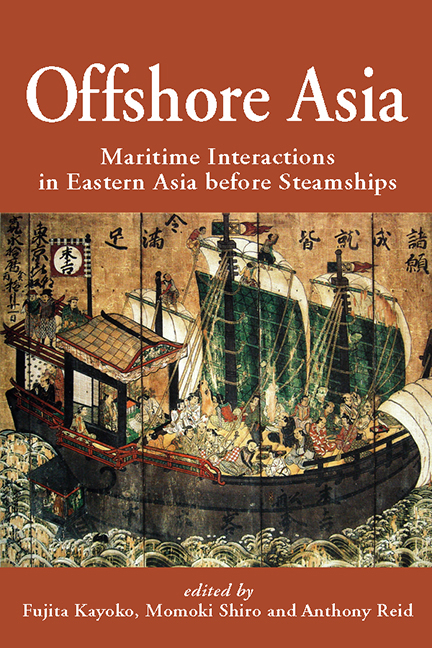Book contents
- Frontmatter
- Contents
- Maps
- Tables and Figures
- Preface
- Contributors
- Map 1 Eastern Asia in the 13th–16th Centuries
- 1 Introduction: Maritime Interactions in Eastern Asia
- 2 The Periodization of Southeast Asian History, in Comparison with that of Northeast Asia
- 3 Merchants, Envoys, Brokers and Pirates: Hokkien Connections in Pre-modern Maritime Asia
- 4 An Asian Commercial Ecumene, 900–1300 ce
- 5 The Japanese Archipelago and Maritime Asia from the 9th to the 14th Centuries
- 6 Saltpetre Trade and Warfare in Early Modern Asia
- 7 Shaping Maritime East Asia in the 15th and 16th Centuries through Choson Korea
- 8 Shipwreck Salvage and Survivors’ Repatriation Networks of the East Asian Rim in the Qing Dynasty
- 9 Wei Zhiyan and the Subversion of the Sakoku
- 10 Metal Exports and Textile Imports of Tokugawa Japan in the 17th Century: The South Asian Connection
- Bibliography of Works Cited
- Index
- NALANDA-SRIWIJAYA SERIES
7 - Shaping Maritime East Asia in the 15th and 16th Centuries through Choson Korea
Published online by Cambridge University Press: 21 October 2015
- Frontmatter
- Contents
- Maps
- Tables and Figures
- Preface
- Contributors
- Map 1 Eastern Asia in the 13th–16th Centuries
- 1 Introduction: Maritime Interactions in Eastern Asia
- 2 The Periodization of Southeast Asian History, in Comparison with that of Northeast Asia
- 3 Merchants, Envoys, Brokers and Pirates: Hokkien Connections in Pre-modern Maritime Asia
- 4 An Asian Commercial Ecumene, 900–1300 ce
- 5 The Japanese Archipelago and Maritime Asia from the 9th to the 14th Centuries
- 6 Saltpetre Trade and Warfare in Early Modern Asia
- 7 Shaping Maritime East Asia in the 15th and 16th Centuries through Choson Korea
- 8 Shipwreck Salvage and Survivors’ Repatriation Networks of the East Asian Rim in the Qing Dynasty
- 9 Wei Zhiyan and the Subversion of the Sakoku
- 10 Metal Exports and Textile Imports of Tokugawa Japan in the 17th Century: The South Asian Connection
- Bibliography of Works Cited
- Index
- NALANDA-SRIWIJAYA SERIES
Summary
In his 2005 book Umi to teikoku — Min-Shin jidai [The Sea and Empire: The Ming-Qing Period], Ueda Makoto writes, “By focusing on the relationship between empire and the sea we can continually pay attention to the contemporaneity of Japan and Southeast Asia, which were linked to China by the sea, and Europe, and to depict the history of Eurasia as a common history.” This approach prompts two observations. First, Ueda's history is a case study of how the sea impacted the history of Ming China and Qing China and, more broadly, the histories of nearby countries and a larger region. Second, Choson Korea is not included in this history of Ming and Qing China and the sea.
That Ueda does not include Choson is understandable. Save for the first several decades of the Ming period, when the capital was located in Nanjing and Korean embassies often travelled there by sea, these two Chinese governments and the Choson government conducted their diplomatic relations through the dispatch overland of embassies to the other country. In addition, Koreans often traded with Chinese and Jurchens north of the Yalu River. Ueda's project encourages the writing of the Choson government and its engagements with the sea as another case study.
Two themes will be discussed in this chapter. The first theme is the maritime space, divided into microregions, in which the Choson government conducted trade from 1392 until 1592. The second is the Choson court's management of maritime trade. Trade in Southeast Asia, the transport of Southeast Asian goods northward to Ryukyu and then to Japan, and the Choson government's structure for managing maritime contact shaped a maritime trade region that continued to connect these areas from at least the late 14th century and the 15th century onward. That structure, a Korean tribute system, a “bureaucratic systematization of the management” of trade missions, arranged Japanese contacts into a hierarchical order of relations with the King of Choson. The Choson government sanctioned trade and accepted items conveyed from Southeast Asia through this structure for routine interaction.
- Type
- Chapter
- Information
- Offshore AsiaMaritime Interactions in Eastern Asia before Steamships, pp. 185 - 210Publisher: ISEAS–Yusof Ishak InstitutePrint publication year: 2013



